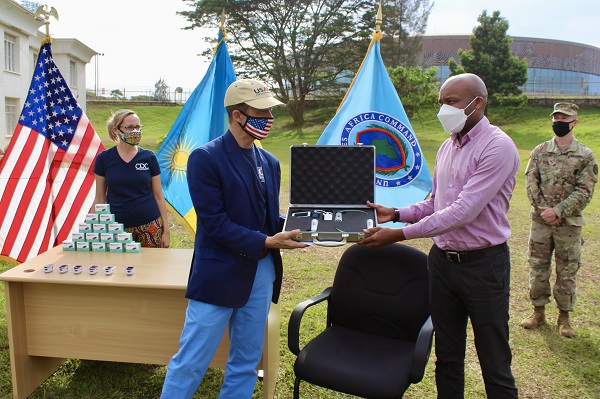
The Government of the United States of America delivered to the Ministry of Health today new medical supplies worth 172 million Rwandan francs as part of the long-standing U.S. commitment to improving health in Rwanda.
U.S. Ambassador to Rwanda Peter H. Vrooman led the handover of almost 100 video laryngoscopes and more than 8,000 pulse oximeters, tools which will provide urgent support to medical practitioners and community health workers around the country as Rwanda fights a new wave of COVID-19 cases.
“The partnership in public health between the United States and Rwanda is helping to save lives every day as we work together to fight COVID-19 and other critical public health challenges,” Ambassador Vrooman said.
The 96 new video laryngoscopes, valued at approximately 500,000 Rwanda francs each, will help Rwandan medical professionals stay safe while ensuring COVID-19 patients get the oxygen they need to survive. Each video laryngoscope kit includes both adult and youth models to ensure maximum versatility.
The 8,300 new pulse oximeters, valued at almost 13,000 Rwandan francs each, will be distributed widely to help community health workers use oxygen levels to identify people that need advanced medical care.
The new medical equipment is funded by the U.S. Department of Defense and comes through the United States Africa Command (AFRICOM) and the United States Overseas Humanitarian, Disaster Assistance, and Civic Aid (U.S. OHDACA) program, a unique humanitarian assistance package that builds Rwanda’s effectiveness to prepare and respond to COVID-19. The donation was coordinated by the U.S. Centers for Disease Control (U.S. CDC), which has played a leading role in supporting Rwanda’s ability to prevent, detect, and respond to COVID-19.
The U.S. donation today is just part of the more than 17 billion Rwandan francs that the United States has invested in Rwanda’s COVID-19 response since March 2020. This support includes the construction of hand-washing stations across Rwanda; support for public communications; staff and vehicles to support contact tracing; laboratory diagnostic equipment and supplies; support for training of frontline workers; medical equipment including ventilators, patient monitors, hospital beds, intensive care units, mobile X-ray machines, video laryngoscopes, and pulse oximeters; and infection prevention and control supplies such as biohazard bags, alcohol, soap, and personal protective equipment.
